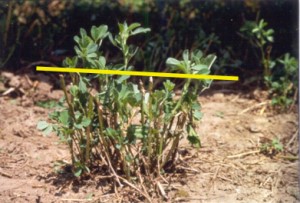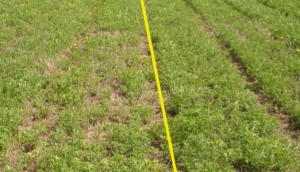Managing Alfalfa and Wheat as Spring Unfolds
Mar 15, 2022
The past few weeks has given us a glimpse of spring in some areas of the state. As refreshing as it might be to see the snow begin to disappear, it means we are greatly stressing our alfalfa and winter wheat fields.
Once things thaw out enough to get a shovel in the ground is a perfect time to go out and assess your fields for any damage that has occurred over the winter. This will allow you to make key decisions on whether to apply early fertilizer, or not, (if the stand is healthy and the field is dry). Or, plan to rotate to a crop of corn instead and utilize the legume credits from the previous alfalfa stand to grow a more economical corn crop for 2018. Taking out questionable fields and rotating to a corn, planting new alfalfa fields with healthier, more productive plants, will aid in being able to grow enough feed that is needed to get your herd through the year.
Alfalfa winter-kill risk?
Heaving from freeze-thaw cycles and ice sheeting are two main reasons for winterkill of alfalfa. Here is some information from Dan Undersander, professor, UW-Madison Department of Agronomy, regarding alfalfa stand considerations.
As alfalfa comes out of dormancy in the spring evaluate stands for condition and yield potential. The earlier the determination, the more possibilities you will have for remedial action. This stand assessment should occur in three parts:
1. Are individual plants alive?
This assessment can begin as soon as the frost is out of the ground and continue until spring green-up occurs. The process is to dig a few plants 4 to 6 inches deep and look at the condition of the taproot. If the taproot is turgid (like a potato, leftmost plant), it is alive and healthy. If the root is browned, dehydrated, and ropey (like two plants on the right), it is dead or dying. This assessment can be repeated until green-up occurs and stand can be assessed on that basis.

Live taproot on left, 2 dead on right
2. Are plants injured?
Alfalfa forms buds in the fall for spring growth. If these buds are killed, the plant must form new buds in the spring, delaying growth and reducing yield. The three taller stems in the picture (above line) are from buds formed in the fall and the shorter stems are from buds formed in the spring. The delayed, shorter growth will reduce yield of first cutting and then plants will recover. If you see this, consider management to reduce this in the future, such as adequate soil pH, fall application of potassium, more winter-hardy varieties.

Tall shoots from fall buds; Short shoots from spring buds
3. Are there thin spots in the field?
A healthy stand should have 55 stems/ft2. Early assessments, before stems are visible, may need to assess based on plant count. A high yielding alfalfa stand seeded last year should have 20 plants/ft2, counts as low as 12 will produce good yield but result in shortened stand life. Stands seeded last spring or fall with less than 12 plants/ft2 should be disked and reseeded.
A high yielding alfalfa stand over 1 year old should have at least 6 plants/ft2. If not, considerations should be given to interseeding the stand with a companion grass or terminating the stand.

Thin Stand (left) vs. Adequate Stand (right)
4. Winter wheat spring management
Most winter kill in Wisconsin is the result of prolonged ice sheets that limit respiration and ultimately “choke-off” the wheat seedlings or exposure due to lack of snow cover. Given the limited snow cover earlier in the winter especially in southern Wisconsin, and now the more recent melting snow and rain resulting in ice sheets on fields the question arises: “will we be experiencing winterkill?”
It is critical to get out early and evaluate winter wheat stands to determine if survival has been compromised enough to limit yield. The reason to get out early is that if a stand is reduced, it becomes that much more important to get an early and timely nitrogen application to maximize spring tillering which will help compensate for the loss of some plants.
When scouting to evaluate a wheat stand, it is important to remember that brown plant leaves do not indicate dead plants and green leaves do not indicate plant survival. You must dig and examine the crown of the plant to determine if healthy, white crown and roots are present.
Assessing how many whole, live plants (not stems and tillers) you have per square foot. The minimum is 12-15 live plants per square foot. This should be an average for your field. Do not use the best or worst areas of the field. If you should decide to tear up a field due to poor stand, first give some consideration to the cost of the replacement crop and what you stand to profit from the switch.
Below is a chart adapted from research conducted by Shawn Conley, state extension soybean and small grain specialist, and John Gaska, senior outreach specialist, University of Wisconsin Extension.


For more information on these and other agronomy topics, contact your United Cooperative agronomist.

Once things thaw out enough to get a shovel in the ground is a perfect time to go out and assess your fields for any damage that has occurred over the winter. This will allow you to make key decisions on whether to apply early fertilizer, or not, (if the stand is healthy and the field is dry). Or, plan to rotate to a crop of corn instead and utilize the legume credits from the previous alfalfa stand to grow a more economical corn crop for 2018. Taking out questionable fields and rotating to a corn, planting new alfalfa fields with healthier, more productive plants, will aid in being able to grow enough feed that is needed to get your herd through the year.
Alfalfa winter-kill risk?
Heaving from freeze-thaw cycles and ice sheeting are two main reasons for winterkill of alfalfa. Here is some information from Dan Undersander, professor, UW-Madison Department of Agronomy, regarding alfalfa stand considerations.
As alfalfa comes out of dormancy in the spring evaluate stands for condition and yield potential. The earlier the determination, the more possibilities you will have for remedial action. This stand assessment should occur in three parts:
1. Are individual plants alive?
This assessment can begin as soon as the frost is out of the ground and continue until spring green-up occurs. The process is to dig a few plants 4 to 6 inches deep and look at the condition of the taproot. If the taproot is turgid (like a potato, leftmost plant), it is alive and healthy. If the root is browned, dehydrated, and ropey (like two plants on the right), it is dead or dying. This assessment can be repeated until green-up occurs and stand can be assessed on that basis.

Live taproot on left, 2 dead on right
2. Are plants injured?
Alfalfa forms buds in the fall for spring growth. If these buds are killed, the plant must form new buds in the spring, delaying growth and reducing yield. The three taller stems in the picture (above line) are from buds formed in the fall and the shorter stems are from buds formed in the spring. The delayed, shorter growth will reduce yield of first cutting and then plants will recover. If you see this, consider management to reduce this in the future, such as adequate soil pH, fall application of potassium, more winter-hardy varieties.

Tall shoots from fall buds; Short shoots from spring buds
3. Are there thin spots in the field?
A healthy stand should have 55 stems/ft2. Early assessments, before stems are visible, may need to assess based on plant count. A high yielding alfalfa stand seeded last year should have 20 plants/ft2, counts as low as 12 will produce good yield but result in shortened stand life. Stands seeded last spring or fall with less than 12 plants/ft2 should be disked and reseeded.
A high yielding alfalfa stand over 1 year old should have at least 6 plants/ft2. If not, considerations should be given to interseeding the stand with a companion grass or terminating the stand.

Thin Stand (left) vs. Adequate Stand (right)
4. Winter wheat spring management
Most winter kill in Wisconsin is the result of prolonged ice sheets that limit respiration and ultimately “choke-off” the wheat seedlings or exposure due to lack of snow cover. Given the limited snow cover earlier in the winter especially in southern Wisconsin, and now the more recent melting snow and rain resulting in ice sheets on fields the question arises: “will we be experiencing winterkill?”
It is critical to get out early and evaluate winter wheat stands to determine if survival has been compromised enough to limit yield. The reason to get out early is that if a stand is reduced, it becomes that much more important to get an early and timely nitrogen application to maximize spring tillering which will help compensate for the loss of some plants.
When scouting to evaluate a wheat stand, it is important to remember that brown plant leaves do not indicate dead plants and green leaves do not indicate plant survival. You must dig and examine the crown of the plant to determine if healthy, white crown and roots are present.
Assessing how many whole, live plants (not stems and tillers) you have per square foot. The minimum is 12-15 live plants per square foot. This should be an average for your field. Do not use the best or worst areas of the field. If you should decide to tear up a field due to poor stand, first give some consideration to the cost of the replacement crop and what you stand to profit from the switch.
Below is a chart adapted from research conducted by Shawn Conley, state extension soybean and small grain specialist, and John Gaska, senior outreach specialist, University of Wisconsin Extension.


For more information on these and other agronomy topics, contact your United Cooperative agronomist.

Pat Van Deurzen
Agronomy Sales Specialist | Northern Region

David Cramer
Filed Under: Agronomy